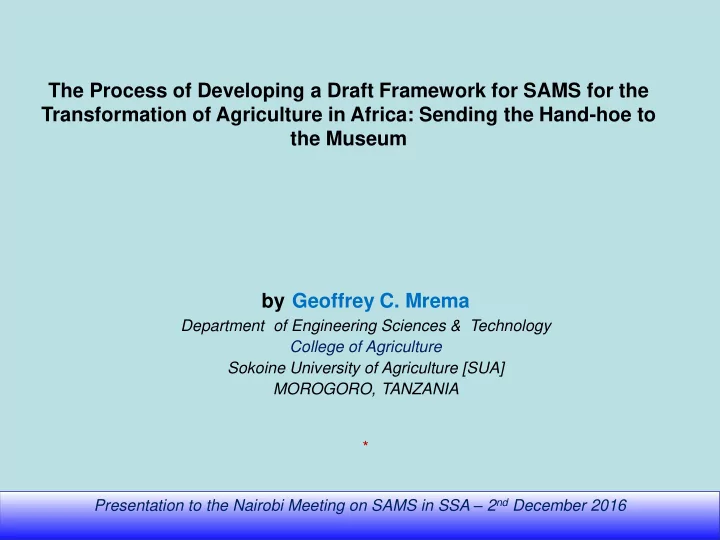

The Process of Developing a Draft Framework for SAMS for the Transformation of Agriculture in Africa: Sending the Hand-hoe to the Museum by Geoffrey C. Mrema Department of Engineering Sciences & Technology College of Agriculture Sokoine University of Agriculture [SUA] MOROGORO, TANZANIA * Presentation to the Nairobi Meeting on SAMS in SSA – 2 nd December 2016
Outline of the Presentation • Introduction • The process of developing a framework for SAMS for SSA/Africa • Sub regional, country studies & Consultations • The next steps from December 2016 to March 2017 • Concluding Comments Presentation to the Nairobi Meeting on SAMS in SSA – 2 nd December 2016
Introduction • In 2015 the AUC initiated a process of developing a SAMS for Africa – one of the follow-ups to decisions made at the 2014 Malabo Summit • AUC decided that one of the main objectives of the initiative should be focused on sending the hand-hoe to the museum by 2035 • The AUC also decided that the SAMS should be anchored on Commercial, Environmental and Socio-economic Sustainability • AUC sought the partnership of key institutions: – FAO; UNECA; AfDB ; the RECs and member countries through its consultative process. • Concept Note was developed through a consultative process during the period January- June 2016; • An Inception Workshop [IW] was convened in Addis in June 2016 and attended by over 35 participants from key institutions in SSA • IW decided on the need to develop a Framework for SAMS Presentation to the Nairobi Meeting on SAMS in SSA – 2 nd December 2016
The Process of Developing a Framework for the SAMS • The Inception Workshop formed a Steering Committee [SC] comprising of representatives of key institutions • The SC Committee met and agreed on the consultative process to be followed in developing the framework for the SAMS: – Review of past studies and reports on agricultural mechanization of the past 50 years – several pan-African studies – Draw lessons from both successful and failed programs and projects of the past - foci so far more on failures – Learn from other sub-sectors e.g. transportation; ICT etc. – Learn from other regions of the world e.g. Asia, LAC etc. – Undertake a number of sub- regional and country studies through consultations with RECs – Framework document should be ready by March 2017 Presentation to the Nairobi Meeting on SAMS in SSA – 2 nd December 2016 Presentation to the 2 nd AAPC – Dar es Salaam 25 th February 2016
Sub-regional and Country Studies • Four experts were commissioned to undertake, through a consultative process, a rapid appraisal of the SAM situation in the four sub – regions: – Central Africa – Professor Mathias Fonteh of Cameroon; – Eastern Africa – Dr. Pascal Kaumbutho of Kenya – Southern Africa – Dr. Mataba Tapela of Botswana – Western Africa – Prof. Emmanuel Ajaw of Nigeria • Sub regional studies being undertaken between September – November 2016 thru consultation with RECs & member countries • A progress review meeting held in October 2016 & another one scheduled for this Sunday and Monday here in Nairobi, • A limited number of country studies [e.g. Rwanda – Dr. Ahmad Adenkule, Uganda etc.] contribute to this process Presentation to the Nairobi Meeting on SAMS in SSA – 2 nd December 2016
The Next Steps • A Team comprising of the four experts, Drs. Noma Mhlanga & Jerome Afeikhena from FAO/SFE & myself are overseeing the process of developing the document under the leadership of Dr. Patrick Kormawa – the FAO Representative to the AUC & UNECA. • AUC and UNECA are briefed on progress periodically on progres s made & they provide their guidance/comments • Stakeholders of agricultural mechanization in SSA will be availed the draft framework document for their comments before a final draft is produced in January 2017, • A Stakeholders workshop is planned in March 2017 to discuss the recommendations in the document , • In accordance with AUC procedures and protocols the document will thereafter be subjected to formal review in its official organs Presentation to the Nairobi Meeting on SAMS in SSA – 2 nd December 2016
Concluding Comments • This will be the first document which is considering agricultural mechanization at pan-Africa level developed by African experts and subjected to an African wide review process, • There have been other documents before notable among them: – The Report of the Goma Conference of 1948; – The World Bank Report prepared by the Team led by Dr. J.C. deWilde of 1967 – recommended establishment of a Centre – The MSU report no.6 of 1969 by Kline et al 1969 - – The Pingali, Biwot & Binswanger book of 1987; – The FAO 2008 publication – Time for a New Look – The FAO/UNIDO document of 2009 – Time for Action • The above reports led to debates and shifts in agricultural mechanization priorities in SSA – hopefully the SAMS framework document will resolve the contentious issues • We look forward to receiving your comments on the draft document Presentation to the Nairobi Meeting on SAMS in SSA – 2 nd December 2016 Presentation to MAFC on the Scoping Study on 3 rd February 2016
Tractor use by region, 1961-2000 Number of Tractors in use 15 (Millions) 10 5 0 1961 1970 1980 1990 2000 Asia North America Sub-Saharan Africa Europe Latin America & Carribean Near East Presentation to the Nairobi Meeting on SAMS in SSA – 2 nd December 2016
Thank you! . Presentation to the Nairobi Meeting on SAMS in SSA – 2 nd December 2016
Recommend
More recommend